COPINH
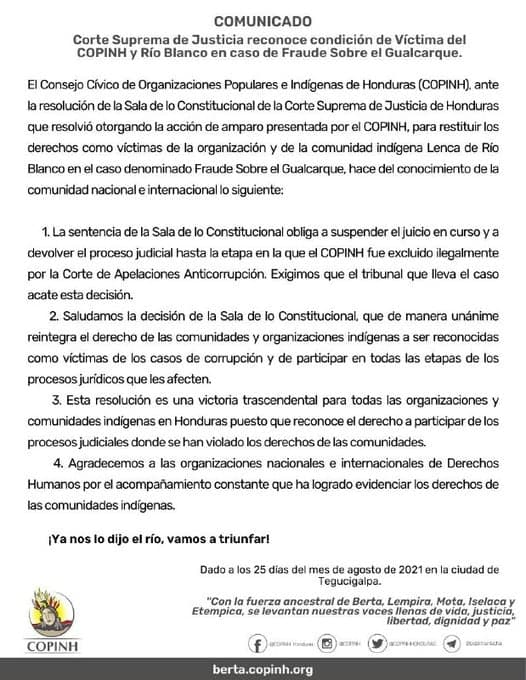

COPINH



#movidaglobal
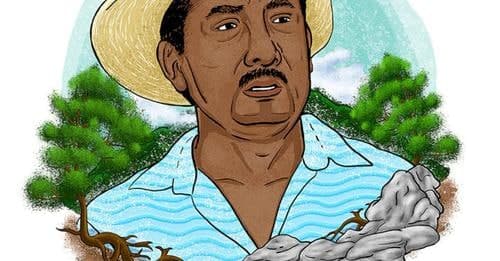

Educa Oaxaca
📌A dos años de su muerte, Hugo Gómez Cruz sigue latiendo en el corazón del COPUDEVER #Oaxaca
Hace dos años, el 22 de agosto del 2019, fue asesinado Hugo Gómez Cruz, ciudadano activo de Paso de la Reyna y defensor del territorio y del Río Verde, su crimen queda en total impunidad. Hugo fue el contacto con la comunidad de Paso de la Reyna y el COPUDEVER, jugó un papel importante para que su comunidad se incorporara al COPUDEVER en el año 2008. En la etapa de estudios para el Proyecto Hidroeléctrico “Paso de la Reina”, él participó activamente en reuniones, en visitar a las comunidades indecisas para dar información de los impactos de los proyectos hidroeléctricos, aparte de motivar a la gente de su comunidad y de otras comunidades para seguir defendiendo el río Verde.
Leer el texto completo: A dos años de su muerte, Hugo Gómez Cruz sigue latiendo en el corazón del COPUDEVER
MAPDER Los Tejemedios Desinformémonos
👉 https://www.educaoaxaca.org/a-dos-anos-de-su-muerte-hugo…/
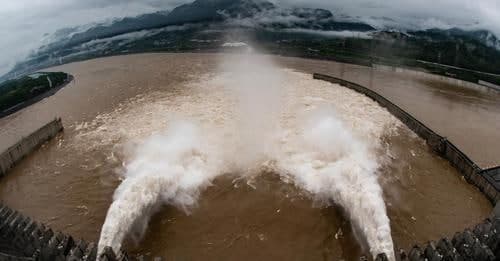
International Rivers
🔴 Cada vez más ingenieros y científicos están discutiendo cómo las represas se vuelven más arriesgadas en un clima extremo impredecible empeorado por #CambioClimático.
Las represas hidroeléctricas son una #FalseSolution para nuestro futuro y una distracción de nosotros verdaderamente abordando el cambio climático. Existen alternativas más verdes y más confiables. Las fuertes precipitaciones incluso provocaron preocupaciones sobre Three Gorges #dam stability. ′′ Debido al cambio climático, podría haber precipitaciones más altas y más elevadas, eso es algo que puede no haber sido considerado durante el proceso de diseño de la presa,» dijo Wen Wang, profesor de hidrología en la Universidad Hohai en Nanjing, añadiendo que es Un gran problema que los ingenieros están prestando atención a ahora, sin embargo, uno que es difícil de construir para dada la dificultad de pronosticar con precisión los volúmenes de lluvia extrema.
READY OR NOT

Published August 11, 2021
The Yangtze river’s periodic flooding was one of the reasons China built the Three Gorges dam, the largest addition to the country’s network of tens of thousands of dams.
The idea was that by storing and then carefully releasing river waters, the country would be able to prevent catastrophes like the floods of 1931, in which millions of people died in cities along the mighty river, or the 1998 floods, that left millions homeless. “The Three Gorges Dam is instrumental in our flood control efforts,” a deputy water resources minister said soon after the completion of the controversial project.
China has about 98,000 dams, most of them small-scale and constructed before the 1970s. In addition to flood control, these dams play an important role in hydroelectric power generation, and ensuring water security. But flooding in recent years due to unusually heavy downpours has drawn more attention to the challenges of managing dams in an era of climate change, when extreme rainfall poses new risks for surrounding communities.
Last month, the Yihetan dam, a major dam in central China’s Henan Province, was breached and “seriously damaged” after the province was hit by torrential rain. Two other dams in north China’s Inner Mongolia region were breached and collapsed after overflowing, affecting more than 16,000 people. Heavy rainfall last year even prompted concerns about the stability of Three Gorges after waters rose above its flood-prevention level, talk that Chinese officials quickly rebuffed.
“Because of climate change there could be higher and higher precipitation, that’s something that may have not been considered during the process of designing the dam,” said Wen Wang, a professor of hydrology at Hohai University in Nanjing, adding that it’s a major issue engineers are paying attention to now, yet one that’s hard to construct for given the difficult of accurately forecasting volumes of extreme rain.
While’s it’s difficult to link any one extreme event to global warming, the new report from the Intergovernmental Panel on Climate Change published Monday (Aug. 9) says that rainfall and floods seen as “once in a decade” events are going to become increasingly more frequent. In east Asia, the IPCC predicts with high confidence that heavy rainfall will increase in frequency and intensity.https://datawrapper.dwcdn.net/j3TBP/2/
Zhengzhou city, in central China’s Henan province, for example, recorded what is typically nearly a year’s worth of rain on a single day. Torrential rain on July 20 caused floods that left more than 300 dead, including many who were trapped in car parks or in the inundated subway system.
Johnny Chan, professor of atmospheric sciences at City University of Hong Kong, said that such levels of precipitation are “unheard of in that part of the country.” But, as the Earth gets warmer, speeding evaporation, this may not remain unusual. “You can expect to see higher and higher frequency of heavy rain,” said Chan.
According to a report commissioned by the National Climate Center, part of China Meteorological Administration, mean temperatures in the country were above normal in every season in 2020. Meanwhile, the annual rainfall for the whole country in 2020 ranked as the fourth-highest since 1951. The heavy rainfall caused extreme floods across southern, central, and eastern China. As a result, water levels at the Three Gorges Dam, the world’s largest hydroelectric plant, located in central China and completed in 2009, rose 6.5 feet above its flood-prevention level.
One of the dams that collapsed this year, the Xinfa dam in Inner Mongolia, was “well constructed and prepared very well (for floods)” said Mohammad Heiderzahad, an associate professor of civil engineering at Brunel University in London. Heiderzahad, who is a dam engineer himself, explained that even so the dam collapsed quickly despite having two spillways and an emergency bottom outlet, which allows for water to be released safely when a dam is in danger of overflowing.
This may have been due to the fact that the unprecedented level of rainfall exceeded the Probable Maximum Flood the dam was designed for, a term that refers to an estimation of the largest flood conceivable where the dam is being constructed.
“If unprecedented flooding is going to be the (new) norm, then large reservoirs would put communities at a big risk” said Heiderzahad. One mitigation step he suggested is adding another emergency spillway under already existing dams to prevent them from overflowing.
In one case last year, officials were forced to blow up a dam that was at risk over overflowing.
Wang, of Hohai University, disagreed that size itself is a risk. Instead, he said collaboration between different reservoirs, and the use of engineering and non-engineering methods of handling water overflow, is what matters. When it appears that engineering methods cannot handle the level of rainfall, dams must empty their reservoirs, he said, a move that is highly reliant on accurate forecasts of precipitation. Learning from last year’s floods, for example, engineers at Three Gorges expelled 90% of the dam’s capacity at the beginning of June this year to brace for the flooding season.
Others note that the age of a dam may be a crucial factor to consider. “The aging dam landscape faces new temperature, snow, discharge, and floods patterns that increase the risk of hydrological failure,” noted a 2021 paper in Nature Communications that described dams as playing a positive role in reducing flood vulnerability. ”To maintain historical levels of flood protection in the face of climate change, new dam release operations will be required.”
If more dams have to release water to accommodate more intense rainfall, however, that could result in flooding in downstream areas, particularly if those flows coincide with rainfall.
“But we have to make a balance,” said Wang. “If the reservoirs are not emptied to prepare for high precipitation events, maybe the dam will collapse, which will cause more and more loss of people and properties.”
👉 http://ow.ly/CfXZ50FT1xv
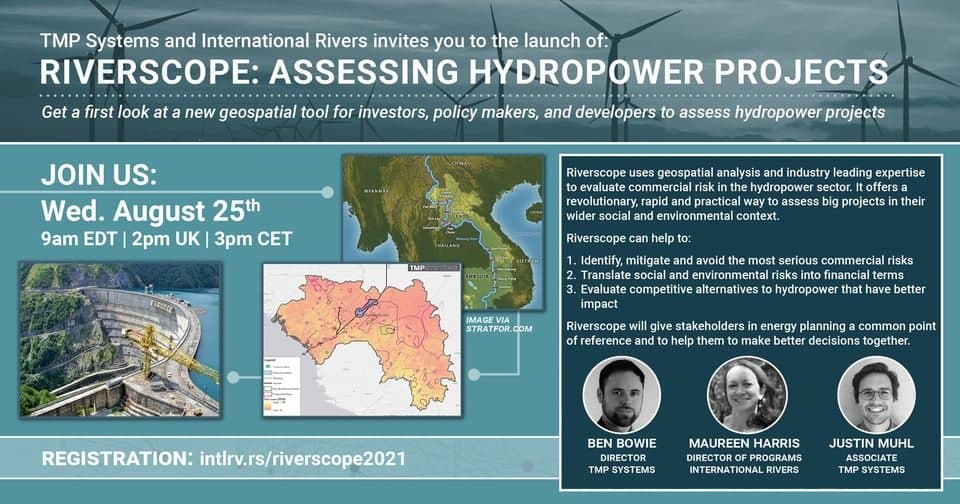
International Rivers

📌 Join us for our public launch of Riverscope, a new tool we developed with TMP Systems.
Riverscope is designed to help investors, planners, and others assess hydropower project risks in specific locations compared to competitive alternatives.
Riverscope can help to:

COPINH
🔴»De los ríos somos custodios ancestrales, el pueblo Lenca, resguardados además por los espíritus de las niñas que nos enseñan que dar la vida de múltiples formas por la defensa de los ríos es dar la vida para el bien de la humanidad y de este planeta» – Berta Cáceres.

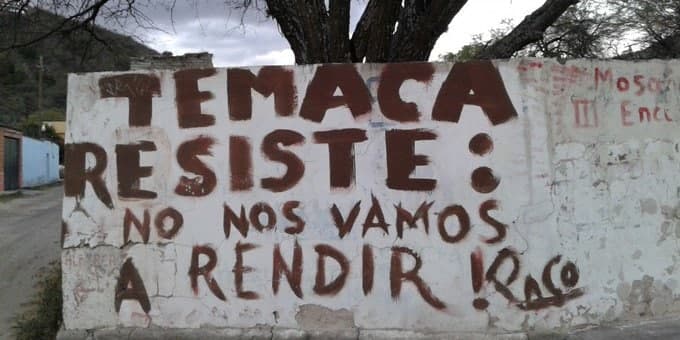
20 agosto, 2021
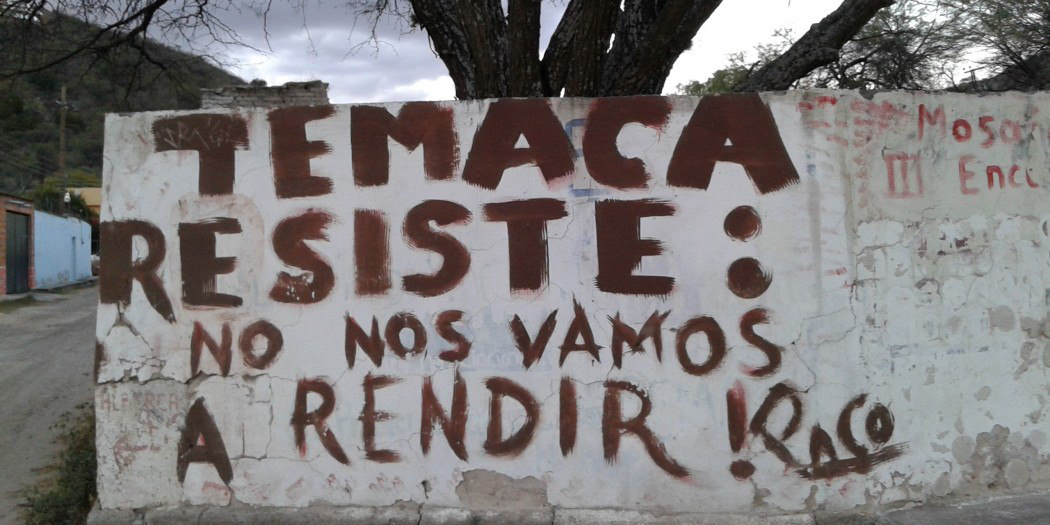
Un grupo de investigadores pide al presidente Andrés Manuel López Obrador que cumpla su promesa de cancelar la presa el Zapotillo, un proyecto «inviable, costoso, antiecológico y socialmente catastrófico» que pondría en riesgo a las comunidades de Temacapulín, Acasico y Palmarejo
Texto: Redacción / Perimetral*
Foto: Perimetral
Este jueves, un grupo de investigadores exigió al presidente Andrés Manuel López Obrador que cancele de manera definitiva la presa El Zapotillo.
Ante los argumentos de López Obrador sobre la que sería injusto para los más pobres no aprovechar la capacidad instalada que dejó esta costosa inversión de la presa durante administraciones anteriores -27 mil 250 millones de pesos-, los académicos niegan que esa injusticia económica esté directamente relacionada con el uso de la infraestructura hídrica.
Y apelan a la corrupción cometida por exfuncionarios en otras obras como el Nuevo Aeropuerto de Mexico, ahora cancelado.
«Como usted lo ha señalado, tiene una relación directa, como lo vimos en el caso del aeropuerto de Texcoco, con el problema de la corrupción en las altas esferas del gobierno y el sector empresarial mexicano y extranjero».
A continuación compartimos la carta íntegra:
ESTIMADO LICENCIADO ANDRÉS MANUEL LÓPEZ OBRADOR
PRESIDENTE CONSTITUCIONAL DE LOS ESTADOS UNIDOS MEXICANOS
Las y los abajo firmantes, en nuestra calidad de ciudadanos, profesionistas y académicos investigadores de diversas instituciones educativas de México, manifestamos nuestra postura con relación a la cancelación o continuidad del proyecto hídrico de la represa El Zapotillo en los Altos de Jalisco.
Fuimos testigos del compromiso que Usted manifestó en su visita a Temacapulín rumbo a las elecciones del 2018, de no desplazar ni inundar a ninguno de los pueblos afectados.
También de cancelar definitivamente la pesadilla que significa para estas comunidades el proyecto citado; el día 12 de agosto de 2019 Usted ratificó su compromiso de campaña.
La operación de la presa El Zapotillo implica poner en riesgo a las comunidades de Temacapulín, Acasico y Palmarejo.
Dicho proyecto es inviable, costoso, antiecológico, socialmente catastrófico.
Ademas es una amenaza a la salud física y mental de las personas y sobre todo NO resuelve el problema de la gestión del agua en los Altos de Jalisco.
Tampoco del abastecimiento de agua en Guadalajara y León Guanajuato.
Ningún experto, científico social o técnico que se respete ha defendido la obra. Es más, la obsolescencia de las represas para gestionar el agua en el mundo está demostrada desde hace al menos dos décadas.
La región donde se ubica el proyecto de la represa es heredera del abandono, la pobreza, altas tasas de migración, pocas oportunidades de empleo, de opciones de vida y rezago educativo.
Así como la alta de servicios de salud, de espacios de recreación, de expresión cultural, de cacicazgos y de violencia.
Todo lo anterior es producto de los gobiernos que precedieron a la presente administración federal.
Resulta necesario resarcir los daños en el que viven estas comunidades, antes que desplazarlas, despojarlas, amenazarlas y desaparecerlas.
Permítanos esgrimir sólo algunos argumentos que se oponen a la valoración económica que en últimas fechas le hemos escuchado en torno a este caso:
Usted ha expuesto que en la obra de la presa El Zapotillo se invirtieron más de 27 mil 250 millones de pesos del pueblo de México.
Con ello sostiene que sería injusto para los más pobres y desprotegidos no aprovechar la capacidad instalada que dejó esta costosa inversión.
Nosotros creemos que las injusticias económicas que padecen más del 70% de la población mexicana no está correlacionada con el uso o no de infraestructura hídrica.
Como usted lo ha señalado, tiene una relación directa, como lo vimos en el caso del aeropuerto de Texcoco, con el problema de la corrupción en las altas esferas del gobierno y el sector empresarial mexicano y extranjero.
De hecho, El Zapotillo, es más un ejemplo de corrupción que de optimización de capacidad instalada para la restauración de la justicia.
Si la presa ya está ahí, no hay razón para concluir esa máquina de muerte ecológica y social.
El punto es que esa construcción no debería de estar ahí y si ahí está es porque durante el proceso de planeación, aprobación, construcción y gestión financiera del proyecto ocurrieron muchas irregularidades.
Siendo fieles a la justicia, no se pueden dejar pasar por alto al momento de tomar decisiones.
Honestamente, no vemos razón alguna para continuar con el calvario que significa esta presa para los pueblos afectados.
Deberíamos estar ocupados en ver la manera de resarcir el daño que ha causado, tantos recursos gastados, tantas horas sin dormir, tantos enfermos, tantos muertos de Temacapulín, Acasico y Palmarejo.
Sensatez, buen ejemplo, justicia, resarcimiento.
Como se habrá dado cuenta, nuestra postura es clara y puntual, exigimos la cancelación definitiva e inmediata de este proyecto de muerte.
FIRMAN
Elvia Susana Delgado Rodríguez, Iker Javier Pulido Rodríguez, Miriam Yolanda Arriaga Tapia, Jorge Ceja Martínez, Jorge Gastón Gutiérrez Rosete Hernández.
Emmanuel Rojas, Lourdes Sofía Mendoza Bohne, Jaime Preciado Coronado, Paula Delgado, Carmen Chinas, Maria Patricia González, Jaime Tamayo, Tanya Elizabeth Méndez Luevano.
David de Anda, Laura Haydeé Cortés Del Real, Daniela Paulina, Iñiguez Vargas, Rosa Iñiguez Vargas, Valeria Michelle Iñiguez Vargas, Leonel Homero Santiago Iñiguez.
Oscar Teodoro Santiago Iñiguez, Ulises Zarazúa, Mónica Montalvo Méndez, Dolores Rojas Rubio, Uriel Nuño Gutiérrez.
Iván García Candelaria, Miguel Ángel Paz Frayre, Sitlali Chino Carrillo, Maritza Rodríguez, Jorge Regalado, Luis Gerardo García Cruz, Ana Cristina Carrillo Salinas., Juan José Ponce López, Naomi Real.
Enrique Castillo Figueroa, Daniel Zepeda, Neyder Yesid Pájaro Jiménez, Elizabeth Mercado Valle, Verónica Martínez Hernández, José Salvador Zepeda López, Alexa Cadena García, Rosa Hernández Solis.
Irene Carrillo Salinas, José Casillas Martínez, Abner Salgado, Anette Saraí Guzmán Galván, Samuel Alcalá, Daniela González, Lesem Padilla, Hilda Márquez Flores, Clarisa Trejo Luna.
Francisco Ivan Delgadillo, Aurelio Márquez Rodríguez, Gisela Espinosa Damian, Aarón González, Rosa Elena Cervantes Castillo, Carmen Ventura, Silvia Chávez Castellanos, Mara Carrillo Salinas.
Edgar Ramón Zúñiga Gómez, Brenda Rodríguez Herrera, Elisa Cárdenas Ayala, Hilda Salazar, Jorge Omar Mora, Miryam Vargas Teutle.
Carolina Montero Pérez, Mónica Aránzazu Lórigo Longoria, Pilar Arrese Alcalá, Margara Millán, Soledad Araly Yovane Castillo, Aida Hernández Castillo.
Yazbeth Pulido Hernández, Silvia Iveth Morales Cruz, Carola Carbajal, Beatriz Olivera, Itzel Silva Monroy, Martha Leticia Contreras Rosales
Angélica Ramos, Luz del Carmen Silva Pérez, Diego Francisco Morales Esquivel, Ofelia Pastrana Moreno, Susana Navarro.
*Responsable del desplegado y posicionamiento: Susana Delgado.
*Esta nota fue realizada por PERIMETRAL, integrante de la alianza de medios de la Red de Periodistas de A Pie. Aquí puedes encontrar la publicación original.

Portal periodístico independiente, conformado por una red de periodistas nacionales e internacionales expertos en temas sociales y de derechos humanos.
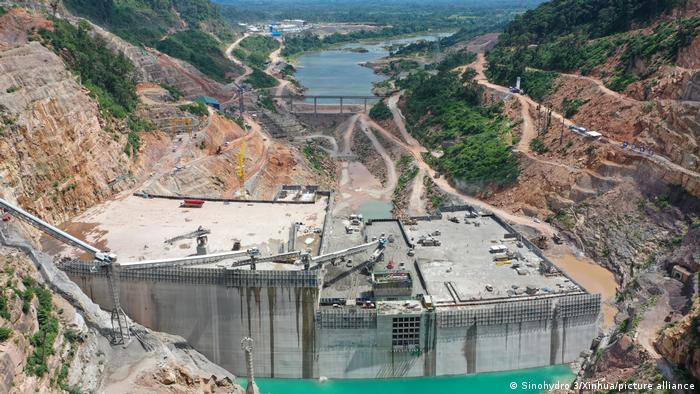
International Rivers
🔴 Communities are enduring unusual flooding & droughts from upstream #dams on the #Mekong. Concerns are being sidelined.
Countries «need to advocate for changes in the way dams are operated to reduce impacts on the river & communities downstream»@paideetes

Experts view the South China Sea as the most probable area of conflict in Asia. Their attention now has also turned to the Mekong River, where the economic and environmental stakes are arguably much higher.
China, one of Laos’ closest political allies and trade partners, is a key investor in Mekong River projects
For several years, US politicians have adopted the Japanese slogan of a «free and open Indo-Pacific,» calling for international law to apply over disputes in the South China Sea, where China is accused of acting aggressively.
Earlier this month, during the East Asia Summit foreign ministers’ meeting, US Secretary of State Antony Blinken called for «a free and open Mekong.»
The latest slogan points to the Mekong River’s importance to peace and stability in mainland Southeast Asia, as well as China’s alleged ambition to gain geopolitical advantage from riparian disputes.
The Mekong River begins in China’s Tibetan Plateau and runs through Myanmar, Laos, Thailand and Cambodia before exiting in Vietnam’s delta region. Hundreds of hydropower dams have been built up and down the river since 2010, and most of them are in China and Laos.
Laos, the poorest member of the Association of Southeast Asian Nations (ASEAN) bloc and a landlocked state without much of a manufacturing sector, has recorded a 7% GDP growth on average for much of the past decade, thanks in large part to exporting hydropower-generated electricity.
However, dam-building has resulted in environmental destruction and accusations of forced evictions and land-clearing across the region.
When part of a dam collapsed in southern Laos in 2018, at least 40 people were killed and hundreds of households in the region were affected by flooding.
The Mekong River begins in China’s Tibetan Plateau and runs through Myanmar, Laos, Thailand and Cambodia before exiting in Vietnam’s delta region
Thailand and Vietnam now also say they are experiencing unusual flooding and droughts because of damming on upstream parts of the Mekong.
Pianporn Deetes, the Thailand and Myanmar campaigns director for International Rivers, a global NGO, argues that an increased American and Chinese interest in Mekong has made the debate «more politicized and polarized.»
The concerns of riparian communities, she adds, are «being overshadowed or sidelined by political agenda.»
Critics say that China could threaten to intentionally hold back much of the river’s water upstream, producing extreme droughts in Thailand and Vietnam, as a way of pressuring Bangkok and Hanoi to accept Beijing’s geopolitical aims. In late July, Chinese hackers allegedly stole data on the Mekong River from Cambodia’s Foreign Ministry servers.
On the other hand, increased funding from US and China-led initiatives to governments and institutions in the region has «contributed to greater public attention and debate on issues critical to the future of the Mekong River and its people,» Deetes told DW.
On August 2, US Secretary of State Blinken co-hosted the second ministerial meeting of the Mekong-US Partnership, created in 2020 to expand the work of a previous forum, the Lower Mekong Initiative. The Beijing-led Lancang-Mekong Cooperation forum was formed in 2016.
«The US emphasis on transparency and inclusivity as part of its Mekong-US Partnership is enabling productive outcomes in the Mekong region and decreasing China’s accountability gap in its own backyard,» said Brian Eyler, director of the Stimson Center’s Southeast Asia program.
There are even claims that despite the conflict, the Mekong River could be one issue on which Beijing and Washington see eye-to-eye. «Environmental conservation of the Mekong is actually a major area of alignment for both the US and China,» Cecilia Han Springer, a senior researcher with the Global China Initiative at the Global Development Policy Center, told DW.
Susanne Schmeier, an associate professor in Water Law and Diplomacy at IHE Delft, identifies two main tensions between China and the Southeast Asian states, and among the Southeast Asian states themselves.
«The data shows that Thailand is the biggest investor in hydropower dams in Laos, building four times as many dams as China,» said Eyler. Watch video 03:18
Thailand is also the biggest importer of electricity generated by Laos’ hydropower dams. But there is already an excess of power generated by the dams in Laos, so Vientiane has «a tall order ahead» to find markets for that power, Eyler added. «It would be wise to pause future dam building until this supply-demand problem is worked out.»
Deetes said, «As a key financier and buyer of electricity from Mekong mainstream and tributary dams in Laos, Thailand has a key role to play to reduce impacts on the Mekong and its people.»
In February 2020, the Thai government ended the China-led Lancang-Mekong Navigation Channel Improvement Project over its possible social and environmental impacts.
In January this year, Thai authorities rejected the new technical report issued by the Chinese developers of the $2 billion (€1.7 billion) Sanakham dam project in Laos, arguing it didn’t assess the environmental impact of downstream communities, mostly those in Thailand itself.
«Thailand should be more proactive in addressing the impacts of the Lancang cascade, including working with other Mekong countries, to advocate for the changes in the ways the dams are operated to reduce impacts on the river and communities downstream,» said Deetes.
But how much influence other Southeast Asian states have over Laos remains in doubt. The bigger problem is whether Laos, as the so-called battery of Asia, could wean its economy off reliance on hydropower investments and exports.
Unlike its neighbors, Laos doesn’t have a large low-cost manufacturing sector. Its exports to the US and the European Union are negligible. The EU imported just €300 million worth of goods from Laos last year, according to European Commission data. Instead, the Lao economy remains heavily dependent on hydropower exports, mining and farming. Watch video 07:27
«I do not think Laos is likely to divert from its current strategy as the export of hydropower to neighboring countries provides a reliable and promising source of income,» said Schmeier.
Neither, Schmeier adds, does Laos’ government have many incentives to diversify its economy. The development of dams provides various opportunities for «additional personal income» for government officials and other actors, she noted.
And China, one of Laos’ closest political allies and trade partners, is a key investor in these projects.
Concerns have been expressed that Laos’ considerable debt to China puts it at risk of Beijing’s alleged «debt-trap diplomacy,» which could force it to sell important state assets away to China in lieu of repayments.
In 2020, a Chinese firm effectively took control of Laos’ domestic electricity grid.
After cataloguing the 100 largest hydropower projects in the Mekong region, Springer found that most of the hydropower projects in Laos plan to export up to 90% of electricity generated abroad. However, she adds, other renewable sources of energy, such as wind and solar, «can meet much of Laos’ electricity demand with similar revenue streams and less capital investment than if the current hydropower pipeline was built.»
https://www.dw.com/en/how-mekong-river-is-turning-into-a-new-flashpoint-in-indo-pacific/a-58842727

Punto de concentración: Zócalo de Acapulco, Gro.
🗓 13 de agosto de 2021
Hora: 11 am.

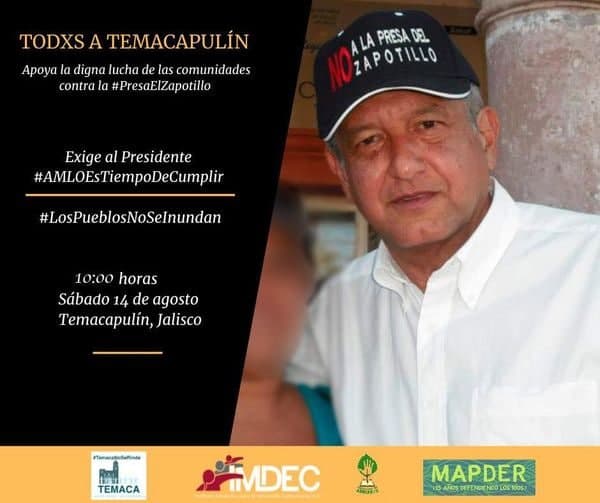
IMDEC A.C.
Sábado 14 de agosto, 10:00 hrs
Temacapulín, Jalisco
Visita del Presidente Andrés Manuel López Obrador, a la comunidad de Temacapulín, Jalisco, al diálogo para encontrar soluciones y alternativas al conflicto sociambiental ocasionado por el megaproyecto.
